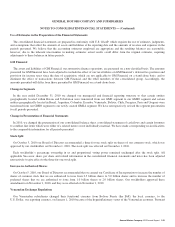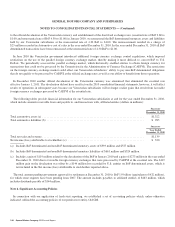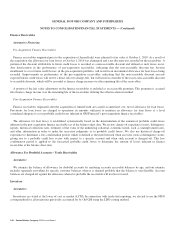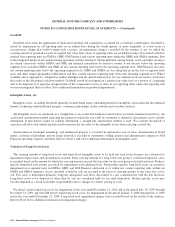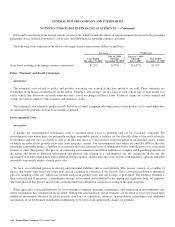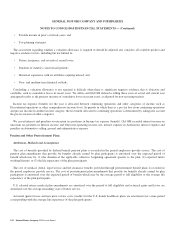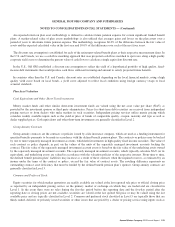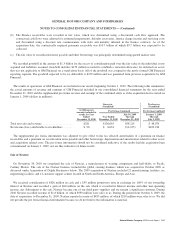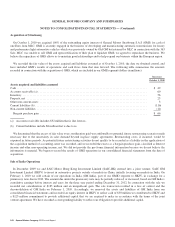General Motors 2010 Annual Report Download - page 155
Download and view the complete annual report
Please find page 155 of the 2010 General Motors annual report below. You can navigate through the pages in the report by either clicking on the pages listed below, or by using the keyword search tool below to find specific information within the annual report.GENERAL MOTORS COMPANY AND SUBSIDIARIES
NOTES TO CONSOLIDATED FINANCIAL STATEMENTS — (Continued)
risk no longer represents a significant input in the determination of the fair value of our derivatives. Consequently, at December 31,
2010 all automotive operations derivatives were reclassified to Level 2.
We record the earnings effect resulting from the change in fair value of automotive operations derivative instruments in Interest
income and other non-operating income, net. We record the earnings effect resulting from the change in fair value of derivative
instruments entered into by GM Financial in GM Financial operating expenses and other.
Effective changes in fair value of derivatives designated as cash flow hedges are recorded in Cash flow hedging gain (losses) within
a separate component of Accumulated other comprehensive income (loss). Amounts are reclassified from Accumulated other
comprehensive income (loss) when the underlying hedged item affects earnings. All ineffective changes in fair value are recorded in
earnings. We also discontinue hedge accounting prospectively when it is determined that a derivative instrument has ceased to be
effective as an accounting hedge or if the underlying hedged cash flow is no longer probable of occurring.
Prior to October 1, 2008, Old GM recorded changes in fair value of derivatives designated as fair value hedges in earnings offset by
changes in fair value of the hedged item to the extent the derivative was effective as a hedge. Old GM recorded the change in fair
value of derivative instruments in the same line item in the consolidated statements of operations as the underlying exposure being
hedged.
As part of Old GM’s quarterly tests for hedge effectiveness in the three months ended December 31, 2008, Old GM was unable to
conclude that its cash flow and fair value hedging relationships continued to be highly effective. Therefore, Old GM discontinued the
application of hedge accounting for derivative instruments used in cash flow and fair value hedging relationships. Old GM recorded
certain releases of deferred gains and losses arising from previously designated cash flow and fair value hedges in earnings. The
earnings effect resulting from the change in fair value of derivative instruments was recorded in the same line item in the consolidated
statements of operations as the underlying exposure being hedged.
We enter into contracts with counterparties that we believe are creditworthy and generally settle on a net basis. We perform a
quarterly assessment of our counterparty credit risk, including a review of credit ratings, credit default swap rates and potential
nonperformance of the counterparty. Based on our most recent quarterly assessment of our counterparty credit risk, we consider this
risk to be low.
The cash flows from derivative instruments are classified in the same categories as the hedged items in the consolidated statement
of cash flows.
Refer to Note 21 for additional information related to derivative transactions.
Income Taxes
The liability method is used in accounting for income taxes. Deferred tax assets and liabilities are recorded for temporary
differences between the tax basis of assets and liabilities and their reported amounts in the consolidated financial statements, using the
statutory tax rates in effect for the year in which the differences are expected to reverse. The effect on deferred tax assets and
liabilities of a change in tax rates is recorded in the results of operations in the period that includes the enactment date under the law.
Deferred income tax assets are evaluated quarterly to determine if valuation allowances are required or should be adjusted. We
establish and Old GM established valuation allowances for deferred tax assets based on a more likely than not standard. The ability to
realize deferred tax assets depends on the ability to generate sufficient taxable income within the carryback or carryforward periods
provided for in the tax law for each applicable tax jurisdiction. We consider and Old GM considered the following possible sources of
taxable income when assessing the realization of deferred tax assets:
• Future reversals of existing taxable temporary differences;
• Future taxable income exclusive of reversing temporary differences and carryforwards;
General Motors Company 2010 Annual Report 153


